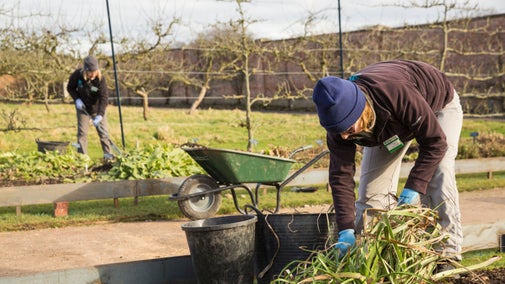
Discover more at Alfriston Clergy House
Find out when Alfriston Clergy House is open, how to get here, the things to see and do and more.

Sir Robert Witt, co-founder of both the National Art Collections Fund and the Courtauld Institute of Art, was the property's tenant from 1907 to his death in 1952. Sir Robert and his wife Lady Mary were largely responsible for the garden that you see today. During the time of his tenancy, it was popular to see the garden as an extension of the house and so gardens often appeared as a series of intimately linked rooms surrounded by hedges and trellis, the concept of ‘garden rooms’. Each ‘room’ often had a theme and a title as they do here at Alfriston.
The Witts terraced the garden toward the river and created the brickwork paths that lead around the garden rooms. During a walk around the garden, you will see many different amphora and large urns, which were brought to the property by Sir Robert Witt. According to a letter by his son John, these amphora and urns were brought back from Naples by his father on his various excursions. They bring a Mediterranean feel to a typical cottage garden.
This part of the garden is laid out in an "Italianate-style" with formal yew hedges and tightly clipped box trees providing an evergreen structure and at the centre sits a sundial. The sundial rests on a balustrade of London's old Waterloo Bridge.
This is the only part of the garden that predates the purchase of the house and garden by the National Trust. The orchard is planted with old and rare varieties of apples such as 'Charles Ross' 'Monarch' ‘Crawley Beauty’, and the Alfriston apple.
– Octavia Hill, National Trust founder
Other notable trees in the orchard include a Mulberry and a Medler.

Another of the areas laid out by the Witts. The large terracotta urn was placed in the garden by Sir Robert in the 1920s, bought back from his travels overseas to Naples. It is home to a large decorative lead water cistern that dates to 1788.
Organic principles guide us in the growing of our produce. Our approach is to disturb the soil a minimum amount in the cultivation of our vegetables, allowing the life in the soil to flourish which creates healthy and resilient crops. Our home-made compost is used as a thick mulch on the beds every winter. We grow beneficial, flowering plants alongside the vegetables, which bring in pollinators and deter predators away from the vegetables. Nasturtiums attract aphids away from broad beans and alliums ward off carrot root fly. During the harvesting season visitors can buy the home grown produce.

The roses in the borders have been chosen for their perfume and are a mix of albas, gallicas, bourbons, rugosas and hybrid musks. They are underplanted with campanulas and other cottage garden favourites.

Find out when Alfriston Clergy House is open, how to get here, the things to see and do and more.
Alfriston Clergy House, the first house to be saved by the National Trust, has centuries of stories to tell. Find out about the owners, the changes to the building and its decline and rescue.

Discover 600-year-old architecture and interiors within this compact medieval house. Get a glimpse of the life led by those that once lived here.

Discover our gardeners’ top tips so you can make the most of your garden, plot or window box.

From 18th-century water gardens and Arts and Crafts landscapes to intimate woodland gardens, there are so many places to discover.

Beautiful gardens are found all over Sussex. The romantic gardens at Nymans and Bateman's; and Capability Brown landscapes at Sheffield Park and Petworth are all yours to explore.
